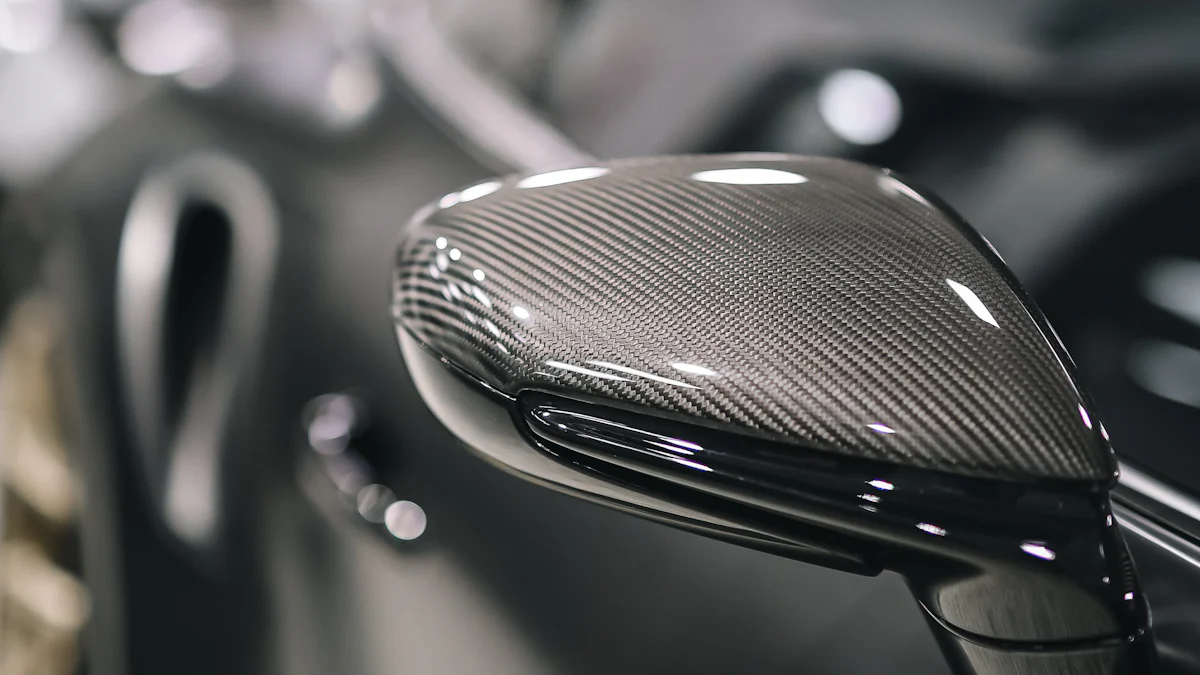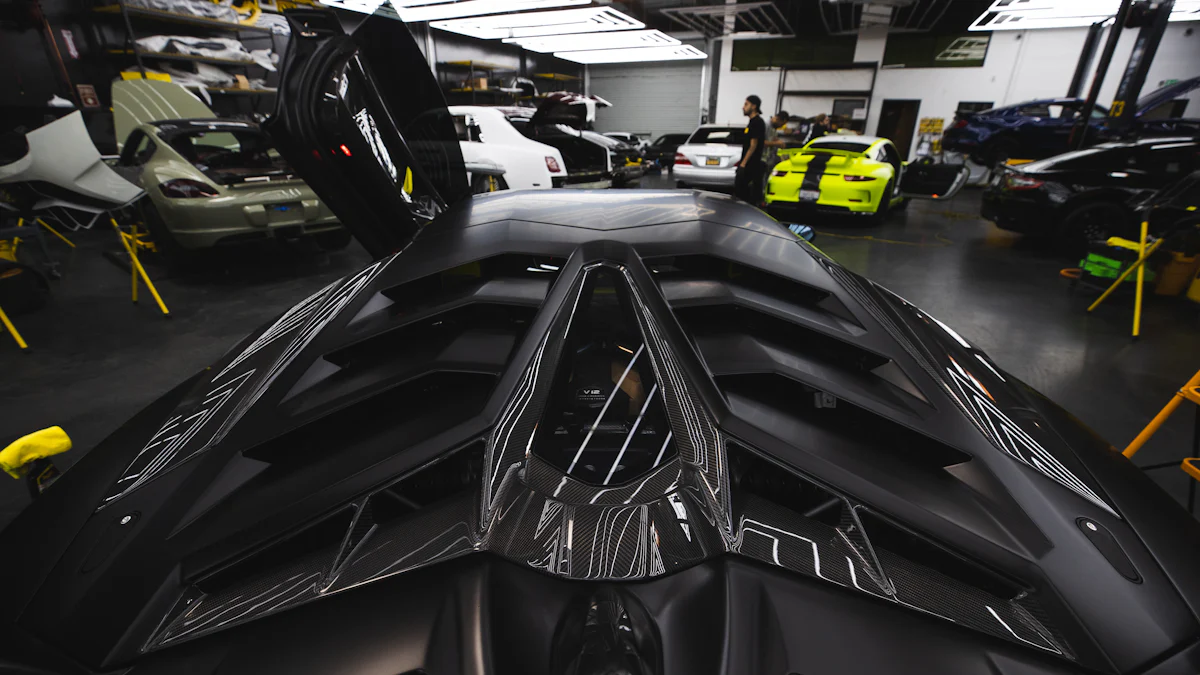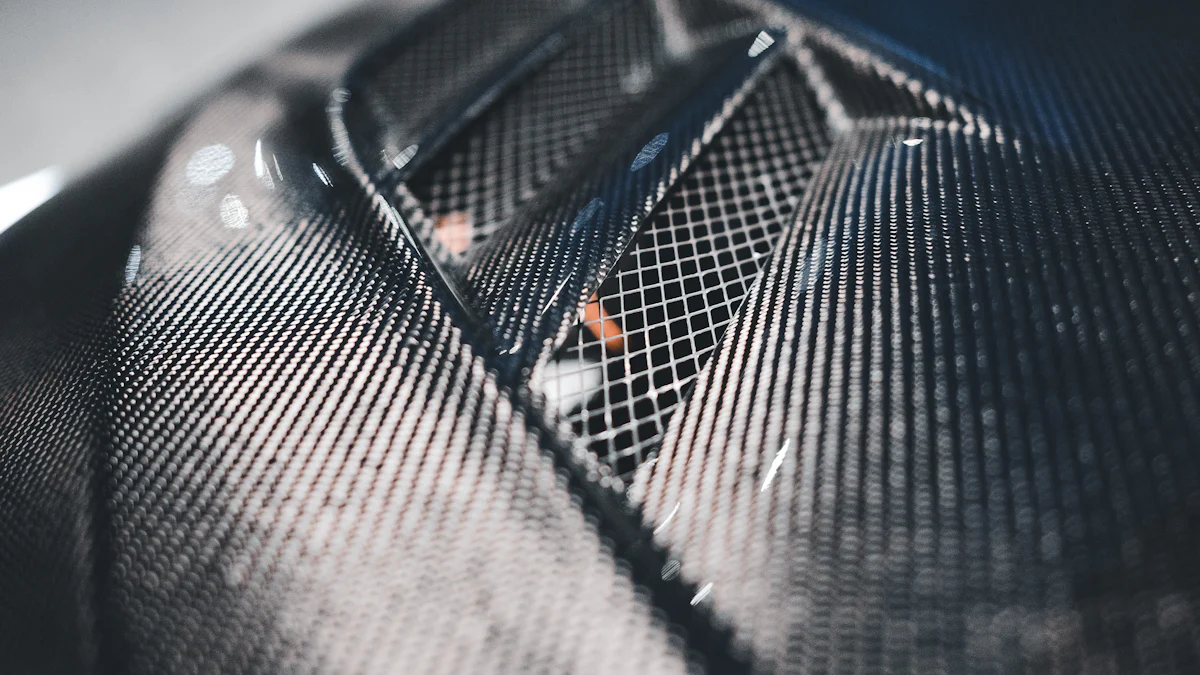What Are the Top Reasons to Use Carbon Fiber in Porsche Cars

Carbon fiber has transformed the automotive industry, and Porsche carbon fiber technology leads the way in utilizing this advanced material. You benefit from its lightweight properties, which enhance speed, handling, and fuel efficiency. For example, the Porsche 911 GT3 incorporates Porsche carbon fiber components to reduce weight while maintaining rigidity, resulting in better performance. The global automotive carbon fiber market, valued at $24.13 billion in 2022, is expected to grow significantly, reflecting its increasing importance. Porsche’s innovative use of carbon fiber in high-performance models sets it apart, offering you unmatched driving experiences.
Key Takeaways
Carbon fiber makes cars lighter, improving speed, stopping, and fuel use.
Porsche cars like the 911 GT3 use carbon fiber for better performance, faster laps, and smoother control.
Carbon fiber is strong but light, making it safe and tough for extreme driving.
You can customize your Porsche with carbon fiber for a cool look and better features.
Porsche cares about the planet by using recycled carbon fiber to cut pollution and stay eco-friendly.
Weight Reduction with Porsche Carbon Fiber

Why Lightweight Materials Matter in Porsche Cars
Lightweight materials play a crucial role in enhancing the driving experience of Porsche cars. By reducing the overall weight, these materials improve acceleration, braking, and fuel efficiency. For instance, every kilogram saved directly contributes to better lap times and sharper handling. In high-performance vehicles like Porsche, lightweight properties also enhance durability, allowing the car to withstand extreme stresses during competitive driving.
Benefit | Description |
|---|---|
Weight Reduction | Every kilogram saved improves acceleration, braking, and fuel efficiency. |
Enhanced Performance | Carbon fiber components in models like the Porsche 911 GT3 improve lap times and handling. |
Durability | Carbon fiber withstands extreme stresses, maintaining performance standards under competitive conditions. |
The use of carbon fiber not only boosts performance but also adds a modern aesthetic appeal. Its unique weave pattern and glossy finish elevate the design of Porsche vehicles, making them stand out on the road.
How Carbon Fiber Reduces Vehicle Mass
Carbon fiber is a game-changer in automotive engineering due to its exceptional strength-to-weight ratio. Porsche cars achieve up to 40 percent weight reduction by replacing traditional materials with carbon fiber in components like the chassis, doors, and hood. This significant reduction enhances the car’s agility and responsiveness.
Specific parts such as the roof, rear wing, and front lid are crafted from carbon fiber to minimize weight without compromising structural integrity. Even smaller elements, like the top half of exterior mirrors and wheel centers, benefit from this material. For example, carbon fiber wheels weigh 8.5 kilograms less than standard alloy wheels, reducing unsprung weight and improving tire performance.
Examples of Lightweight Porsche Models
Porsche has integrated carbon fiber into several of its iconic models to achieve remarkable weight savings. The Porsche 911 GT3 stands out as a prime example, utilizing carbon fiber components to maintain high rigidity while reducing mass. Other models feature carbon fiber in critical areas such as the bucket seats, underfloor, and center console.
Limited-edition models often showcase extensive use of carbon fiber, creating a sense of exclusivity and desirability. These lightweight designs not only enhance performance but also reflect Porsche’s commitment to innovation and engineering excellence.
Performance Enhancements Through Carbon Fiber
Boosting Acceleration and Speed
Carbon fiber plays a vital role in improving the acceleration of Porsche cars. By significantly reducing the weight of critical components, it allows the engine to deliver power more efficiently. You experience faster lap times and quicker sprints on the track. For instance:
Weight reduction from carbon fiber enhances overall performance, including acceleration.
Every kilogram saved improves acceleration, braking, and fuel efficiency.
The Porsche 911 GT3 exemplifies this advantage. Its carbon fiber construction ensures low weight while maintaining high rigidity. This combination results in rapid acceleration and better handling. Whether you’re on the road or the racetrack, the lightweight design ensures you feel the difference in speed and responsiveness.
Improving Handling and Cornering
Carbon fiber enhances handling and cornering by reducing weight and improving structural integrity. The Weissach package, available for select Porsche models, includes a lighter roll bar made from carbon fiber-reinforced plastic (CFRP). This roll bar saves approximately 6 kilograms compared to steel, while magnesium wheels save an additional 8 kilograms. These reductions make the car more agile and responsive during sharp turns.
Additionally, Porsche’s aerodynamic systems, such as the carbon fiber underfloor cover and adjustable rear spoiler, optimize downforce. This system generates 4,000 Newtons (900 lb) of downforce with a 30:70 front-to-rear distribution. You benefit from improved stability and precision when navigating corners at high speeds.
Real-World Performance in Porsche Sports Cars
Porsche sports cars demonstrate the real-world benefits of carbon fiber. The Porsche 911 GT3, for example, achieves a weight reduction of up to 40% compared to steel components. This reduction translates to faster lap times and quicker turn-ins on the track. The carbon fiber underfloor cover not only reduces weight but also enhances aerodynamics, ensuring optimal performance.
These innovations highlight Porsche’s commitment to delivering enhanced performance through cutting-edge materials. When you drive a Porsche equipped with carbon fiber, you experience the perfect balance of speed, agility, and control.
Durability and Safety Benefits of Carbon Fiber
High Strength-to-Weight Ratio
Carbon fiber offers an exceptional high strength-to-weight ratio, making it a standout material in automotive engineering. It is significantly stronger than steel while being two-thirds lighter. This combination allows Porsche to design vehicles that are both lightweight and incredibly robust. By replacing traditional materials like steel or aluminum with carbon fiber, Porsche cars achieve up to 50% weight reduction. This not only enhances performance but also improves fuel efficiency.
The specific strength of carbon fiber far exceeds that of most metals, enabling it to reinforce critical vehicle components. For example, parts like the chassis and roof benefit from this material’s superior mechanical properties. You experience a car that feels lighter yet remains structurally sound, even under extreme driving conditions.
Crashworthiness and Driver Protection
Porsche integrates carbon fiber into its vehicles to enhance crashworthiness and protect drivers. The material’s unique properties allow it to absorb and dissipate impact forces effectively. For instance:
Carbon fiber cage structures act as protective barriers, shielding passengers during collisions.
Upon impact, carbon fiber breaks quickly, minimizing local deflection compared to metals.
Its design ensures that crash forces travel downward, reducing the risk of injury.
These features make carbon fiber a safer choice for high-performance vehicles. Models like the Porsche 911 GT3 utilize this material to combine lightweight construction with superior safety. You can drive confidently, knowing that carbon fiber enhances both performance and protection.
Resistance to Wear and Environmental Factors
Carbon fiber exhibits remarkable resistance to wear and environmental factors, contributing to its increased durability. Unlike metals, it does not rust or corrode, ensuring that components maintain their strength and appearance over time. Its stiffness surpasses that of plastics, making it ideal for precision parts.
Additionally, carbon fiber withstands harsh environmental conditions, such as extreme temperatures and moisture. This resilience ensures that Porsche cars remain reliable and efficient in various climates. By using carbon fiber, Porsche not only enhances durability but also supports sustainability goals. The material’s lightweight nature reduces fuel consumption and emissions, aligning with modern environmental standards.
Design Flexibility and Aesthetic Innovation

Creating Aerodynamic and Complex Shapes
Carbon fiber allows Porsche to create aerodynamic and intricate shapes that enhance performance. Its lightweight and strong properties make it ideal for designing components that optimize airflow and reduce drag. For example:
Carbon fiber underfloor covers improve downforce and stability.
Features like diffusers, ventilation channels, and air fins enhance aerodynamics.
Designs achieve up to 4,000 Newtons (900 lb) of downforce, ensuring better grip and control.
You benefit from these innovations when driving at high speeds. Front splitters, crafted from carbon fiber or aluminum, manipulate air pressure to generate downforce. Rear diffusers transition air smoothly, reducing drag and improving handling. These designs not only boost performance but also give Porsche cars their aggressive and sporty appearance.
Customization Options for Porsche Owners
Carbon fiber offers you endless customization possibilities. Its distinctive weave pattern and glossy finish add a modern, high-tech touch to your Porsche. Interior elements like dashboard trims and door panels showcase the material’s exclusivity and performance pedigree. You can replace original plastic parts with carbon fiber components inspired by top RS models, enhancing both aesthetics and functionality.
High-performance models like the 991, 981, and 718 in GT2, GT3, and GT4 versions often feature these upgrades. Companies like Gunther Works collaborate with you to create bespoke designs. They offer custom paint colors and details, blending modern amenities with classic elements like carbon fiber shell seats. These options let you personalize your car while maintaining its sporty and sophisticated look.
Iconic Porsche Designs Enabled by Carbon Fiber
Carbon fiber has shaped some of Porsche’s most iconic designs. The Porsche Carrera GT, for instance, uses carbon fiber extensively in its chassis, doors, and seats. This design achieves significant weight savings while maintaining structural integrity. Developed with racing technology, the Carrera GT demonstrates how carbon fiber enhances performance in a street-legal vehicle.
The Porsche 911 GT3 also benefits from carbon fiber components. These parts reduce weight and improve rigidity, resulting in better acceleration and handling. Carbon fiber’s strength ensures durability under extreme conditions, while its energy absorption properties enhance safety. These innovations highlight how Porsche combines cutting-edge materials with engineering excellence to deliver exceptional vehicles.
Sustainability and Efficiency with Carbon Fiber
Reducing Fuel Consumption and Emissions
Carbon fiber significantly reduces vehicle weight, which directly impacts fuel consumption and emissions. Lighter cars require less energy to accelerate, brake, and maintain speed. For example, the Porsche 911 GT3 uses carbon fiber components to achieve a lightweight structure while maintaining rigidity. This design improves fuel efficiency and reduces the car’s carbon footprint. By incorporating carbon fiber, you benefit from a vehicle that performs better while being more environmentally friendly.
Additionally, lighter vehicles emit fewer pollutants, contributing to cleaner air and a healthier environment. Carbon fiber’s role in reducing emissions aligns with modern sustainability goals. As a Porsche owner, you can enjoy high performance while knowing your car supports eco-friendly practices.
Porsche’s Commitment to Sustainable Materials
Porsche actively works to make carbon fiber more sustainable. The company has developed innovative recycling processes to repurpose carbon fiber materials, minimizing waste. These efforts ensure that carbon fiber remains a viable option for future applications.
Porsche has implemented a sustainability rating for its suppliers. Over 90% of suppliers now hold a valid rating, supporting Porsche’s goal of achieving a carbon-neutral balance sheet by 2030.
The use of recycled fibers in models like the Taycan demonstrates Porsche’s commitment to sustainable materials.
By choosing a Porsche, you support a brand that prioritizes environmental responsibility and innovation.
Innovations in Carbon Fiber Technology
Porsche continues to push the boundaries of carbon fiber technology. Lightweight vehicles made with carbon fiber consume less fuel and produce lower emissions, reducing their environmental impact. The material’s strength allows for components that withstand extreme stresses during high-speed driving. This ensures your car maintains performance standards while staying durable.
The distinctive weave pattern and glossy finish of carbon fiber enhance the modern look of Porsche vehicles. Interior elements, such as dashboard trims and door panels, showcase the material’s exclusivity. Limited-edition models often feature extensive carbon fiber, creating a sense of uniqueness and desirability.
Porsche’s advancements in recycling processes further promote the sustainable use of carbon fiber. These innovations highlight the brand’s dedication to combining performance with environmental stewardship.
Carbon fiber plays a vital role in Porsche’s engineering excellence. It reduces weight, improving acceleration, braking, and fuel efficiency. Its strength ensures durability under high-speed driving, while its energy absorption enhances safety. You also benefit from its modern aesthetic, with a distinctive weave pattern that adds exclusivity. Limited-edition models showcase extensive carbon fiber use, reflecting Porsche’s commitment to luxury and innovation. By integrating this material, Porsche delivers vehicles that combine cutting-edge performance with sustainability, offering you an unmatched driving experience.
FAQ
What makes carbon fiber better than traditional materials in Porsche cars?
Carbon fiber offers a higher strength-to-weight ratio compared to steel or aluminum. It reduces vehicle weight by up to 50%, improving acceleration, handling, and fuel efficiency. Its durability ensures long-lasting performance, even under extreme conditions.
How does carbon fiber improve safety in Porsche vehicles?
Carbon fiber absorbs and dissipates crash forces effectively. Its cage structures protect passengers by minimizing impact deflection. This material directs crash energy downward, reducing injury risks and enhancing overall safety.
Can you customize carbon fiber components in your Porsche?
Yes, you can personalize carbon fiber elements like dashboard trims, door panels, and seats. Porsche offers customization options, allowing you to enhance both aesthetics and functionality. These upgrades add a modern, sporty touch to your car.
Does carbon fiber help reduce a Porsche’s environmental impact?
Yes, carbon fiber reduces vehicle weight, which lowers fuel consumption and emissions. Porsche also uses recycled carbon fiber in some models, aligning with sustainability goals. You enjoy high performance while supporting eco-friendly practices.
Which Porsche models feature extensive use of carbon fiber?
Models like the Porsche 911 GT3 and Carrera GT showcase extensive carbon fiber use. These vehicles incorporate lightweight components in areas like the chassis, roof, and seats. Limited-edition models often highlight carbon fiber for exclusivity and performance.
